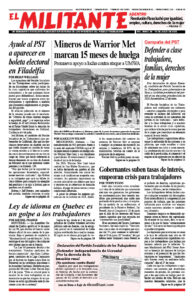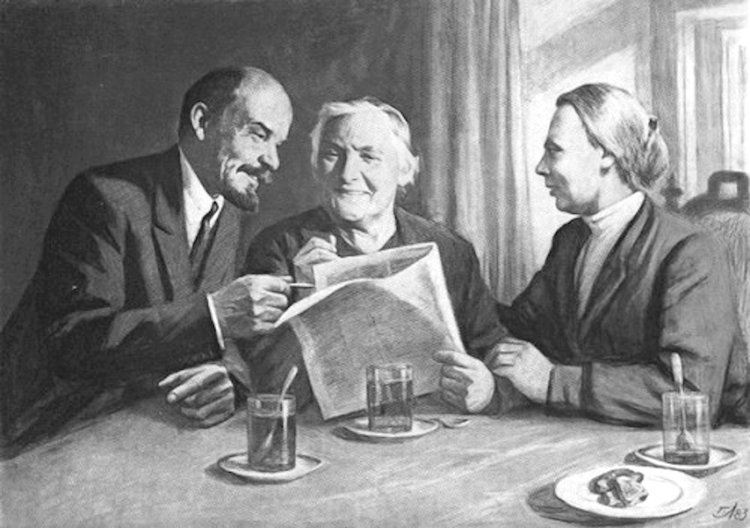The special feature this week is excerpts from an interview Clara Zetkin did with V.I. Lenin in 1920, part of preparations for her drafting a resolution for communist work among women for the Third Congress of the Communist International a year later. Lenin, the central leader of the 1917 Bolshevik Revolution, explained the fight for women’s equality as part of the unfolding socialist revolution in Russia. “The woman question,” he said, is “part of the social, working-class question,” and the task of communists is “to bind it firmly with the proletarian class struggle and the revolution.” The goal, he added, must be a mass movement of women “of all the exploited and oppressed.” The interview by Zetkin, a leader of the German Communist Party, is in The Emancipation of Women, available from Pathfinder.
The first proletarian dictatorship is truly paving the way for the complete social equality of women. It eradicates more prejudice than volumes of feminist literature. However, in spite of all this, we do not yet have an international Communist women’s movement and we must have one without fail. …
[T]rue emancipation of women is not possible except through communism. You must lay stress on the unbreakable connection between woman’s human and social position and the private ownership of the means of production. This will draw a strong, ineradicable line against the bourgeois movement for the “emancipation of women.” This will also give us a basis for examining the woman question as part of the social, working-class question, and to bind it firmly with the proletarian class struggle and the revolution. The communist women’s movement itself must be a mass movement, a part of the general mass movements; and not only of the proletarians, but of all the exploited and oppressed, of all victims of capitalism or of the dominant class. Therein, too, lies the significance of the women’s movement for the class struggle of the proletariat and its historic mission, the creation of a communist society. We can be legitimately proud that we have the flower of revolutionary womanhood in our Party, in the Comintern. But this is not decisive, we have to win over the millions of working women in town and country for our struggle and, particularly, for the communist reconstruction of society. There can be no real mass movement without the women.
We derive our organizational ideas from our ideological conceptions. We want no separate organizations of communist women! She who is a Communist belongs as a member to the Party, just as he who is a Communist. They have the same rights and duties. There can be no difference of opinion on that score. However, we must not shut our eyes to the facts. The Party must have organs, working groups, commissions, committees, sections or whatever else they may be called — with the specific purpose of rousing the broad masses of women, bringing them into contact with the Party and keeping them under its influence. This naturally requires that we carry on systematic work among the women … not only proletarian women, whether they work in mills or cook the family meal. I also have in mind the peasant women and the women of the various sections of the lower middle class. They, too, are victims of capitalism, and more than ever since the war. …
We cannot exercise the dictatorship of the proletariat without having millions of women on our side. Nor can we engage in communist construction without them. We must find a way to reach them. …
We must combine our appeal politically in the minds of the female masses with the sufferings, the needs and the wishes of the working women. They should all know what the proletarian dictatorship will mean to them — complete equality of rights with men, both legal and in practice, in the family, the state and in society, and that it also spells the annihilation of the power of the bourgeoisie. …
The government of the proletarian dictatorship — jointly with the Communist Party and the trade unions of course — makes every effort to overcome the backward views of men and women and thus uproot the old, non-communist psychology. It goes without saying that men and women are absolutely equal before the law. A sincere desire to give effect to this equality is evident in all spheres. We are enlisting women to work in the economy, the administration, legislation and government. All courses and educational institutions are open to them, so that they can improve their professional and social training. We are organizing community kitchens and public dining-rooms, laundries and repair shops, creches, kindergartens, children’s homes and educational institutions of every kind. In brief, we are quite in earnest about carrying out the requirements of our program to shift the functions of housekeeping and education from the individual household to society. Woman is thus being relieved from her old domestic slavery and all dependence on her husband. She is enabled to give her capabilities and inclinations full play in society. Children are offered better opportunities for their development than at home. We have the most progressive female labor legislation in the world, and it is enforced by authorized representatives of organized labor. We are establishing maternity homes, mother-and-child homes, mothers’ health centers, courses for infant and child care, exhibitions of mother and child care, and the like. We are making every effort to provide for needy and unemployed women.
We know perfectly well that all this is still too little, considering the needs of the working women, and that it is still far from sufficient for their real emancipation. Yet it is an immense stride forward from what there was in tsarist and capitalist Russia. Moreover, it is a lot as compared with the state of affairs where capitalism still holds undivided sway. … Think what this means in a country where the peasants comprise a solid 80% of the population. Small peasant farming implies individual housekeeping and the bondage of women. You will be far better off than we are in this respect, provided your proletarians at last grasp that the time is historically ripe for seizure of power, for revolution.


